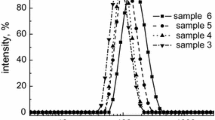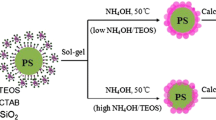Abstract
Micron-scale hollow spheres were successfully constructed with silica nanoparticles by templating of polymer spheres. Subsequently, the use of 3-aminopropyltriethoxysilane (APTES) introduces carbon and oxygen defects in the silica nanoparticles resulting from calcination of the aminopropyl group. In this approach, the template of micron-scale polymer spheres was prepared from dispersion polymerization. Subsequent Stöber process results in the formation of a silica layer attached to the polymer sphere surfaces. After calcination, the obtained micron-scale hollow silica spheres were then studied on the relationship between the particle diameter and the surface morphology. The luminescence of hollow spheres was prepared through using APTES in Stöber process, and which of related the appearance of luminescence to the APTES concentration and calcination temperature. The results of this study can provide useful information for the structure of micron-scale hollow spheres and their application to luminescent materials.







Similar content being viewed by others
References
Yang SC, Yang DJ, Kim J, Hong JM, Kim HG, Kim ID, Lee H (2008) Hollow TiO2 hemispheres obtained by colloidal templating for application in dye-sensitized solar cells. Adv Mater 20:1059–1064
Eun TH, Kim SH, Jeong WJ, Jeon SJ, Kim SH, Yang SM (2009) Single-step fabrication of monodisperse TiO2 hollow spheres with embedded nanoparticles in microfluidic devices. Chem Mater 21:201–203
Arnal PM, Comotti M, Schüth F (2006) High-temperature-stable catalysts by hollow sphere encapsulation. Angew Chem 118:8404–8407
Tang S, Huang X, Chen X, Zheng N (2010) Hollow mesoporous zirconia nanocapsules for drug delivery. Adv Funct Mater 20:2442–2447
Xu X, Asher SA (2004) Synthesis and utilization of monodisperse hollow polymeric particles in photonic crystals. J Am Chem Soc 126:7940–7945
Bruinsma PJ, Kim AY, Liu J, Baskaran S (1997) Mesoporous silica synthesized by solvent evaporation: spun fibers and spray-dried hollow spheres. Chem Mater 9:2507–2512
Hentze HP, Raghavan SR, McKelvey CA, Kaler EW (2003) Silica hollow spheres by templating of catanionic vesicles. Langmuir 19:1069–1074
Yuan J, Bai X, Zhao M, Zheng L (2010) C12mimBr ionic liquid/SDS vesicle formation and use as template for the synthesis of hollow silica spheres. Langmuir 26:11726–11731
Caruso F, Caruso RA, Möhwald H (1998) Nanoengineering of inorganic and hybrid hollow spheres by colloidal templating. Science 282:1111–1114
Imhof A (2001) Preparation and characterization of titania-coated polystyrene spheres and hollow titania shells. Langmuir 17:3579–3585
Luna-Xavier J, Guyot A, Bourgeat-Lami EJ (2002) Synthesis and characterization of silica/poly (methyl methacrylate) nanocomposite latex particles through emulsion polymerization using a cationic azo initiator. Colloid Interface Sci 250:82–92
Graf C, Vossen DLJ, Imhof A, Blaaderen A (2003) A general method to coat colloidal particles with silica. Langmuir 19:6693–6700
Lu Y, McLellan J, Xia Y (2004) Synthesis and crystallization of hybrid spherical colloids composed of polystyrene cores and silica shells. Langmuir 20:3464–3470
Pu H, Zhang X, Yuan J, Yang Z (2009) A facile method for the fabrication of vinyl functionalized hollow silica spheres. J Colloid Interface Sci 331:389–393
Zhang L, D’Acunzi M, Kappl M, Auernhammer GK, Vollmer D, Kats CM, Blaaderen A (2009) Hollow silica spheres: synthesis and mechanical properties. Langmuir 25:2711–2717
Smith JN, Meadows J, Williams PA (1996) Adsorption of polyvinylpyrrolidone onto polystyrene latices and the effect on colloid stability. Langmuir 12:3773–3778
Sato T, Kohnosu S (1994) Effect of polyvinylpyrrolidone on the physical properties of titanium dioxide suspensions. Colloids and Surfaces A Physicochem Eng Aspects 88:197–205
Lee J, Ha JU, Choe S, Lee CS, Shim SE (2006) Synthesis of highly monodisperse polystyrene microspheres via dispersion polymerization using an amphoteric initiator. J Colloid Interface Sci 298:663–671
Kawaguchi S, Ito K (2005) Dispersion polymerization. Adv Polym Sci 175:299–328
Jakob AM, Schmedake TA (2006) A novel approach to monodisperse, luminescent silica spheres. Chem Mater 18:3173–3175
Enrichi F, Ann NY (2008) Luminescent amino-functionalized or erbium-doped silica spheres for biological applications. Acad Sci 1130:262–266
Soriano RB, Kpatcha E, Jakob AM, Merkert JW, Carlin CM, Schmedakea TA (2007) Long-lifetime emission in luminescent colloidal silica. Appl Phys Lett 91:091909
Kong D, Zhang C, Xu Z, Li G, Hou Z, Lin J (2010) Tunable photoluminescence in monodisperse silica spheres. J Colloid Interface Sci 352:278–284
Zhao Y, Li Y, Li W, Wu Y, Wu L (2010) Preparation, structure, and imaging of luminescent SiO2 nanoparticles by covalently grafting surfactant-encapsulated europium-substituted polyoxometalates. Langmuir 26:18430–18436
Carlos LD, Sa’Ferreira RA, Pereira RN, Assunção M, Bermudez VZ (2004) White-light emission of amine-functionalized organic/inorganic hybrids: emitting centers and recombination mechanisms. J Phys Chem B 108:14924–14932
Liu YY, Chen H, Ishizu K (2011) Facile surface immobilization of ATRP initiators on colloidal polymers for grafting brushes and application to colloidal crystals. Langmuir 27:1168–1174
Author information
Authors and Affiliations
Corresponding author
Rights and permissions
About this article
Cite this article
Liu, YY., Cheng, SL. & Chen, H. Architecture of micron-scale hollow spheres composed of silica nanoparticles and approach to luminescent spheres. Colloid Polym Sci 290, 1777–1784 (2012). https://doi.org/10.1007/s00396-012-2716-9
Received:
Revised:
Accepted:
Published:
Issue Date:
DOI: https://doi.org/10.1007/s00396-012-2716-9




